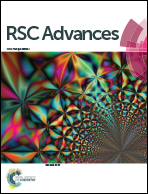Electronic and optical properties of BxCyNz hybrid α-graphynes†
Abstract
Hybrid two-dimensional (2D) materials composed of carbon, boron, and nitrogen constitute a hot topic of research, as their flexible composition allows for tunable properties. However, while graphene-like hybrid lattices have been well characterized, systematic investigations are lacking for various 2D materials. Hence, in the present contribution, we employ first-principles calculations to investigate the structural, electronic and optical properties of what we call BxCyNz hybrid α-graphynes. We considered eleven structures with stoichiometry BC2N and varied atomic arrangements. We calculated the formation energy for each arrangement, and determined that it is low (high) when the number of boron-carbon and nitrogen-carbon bonds is low (high). We found that the formation energy of many our structures compared favorably with a previous literature proposal. Regarding the electronic properties, we found that the investigated structures are semiconducting, with band gaps ranging from 0.02 to 2.00 eV. Moreover, we determined that most of the BxCyNz hybrid α-graphynes proposed here strongly absorb infrared light, and so could potentially find applications in optoelectronic devices such as heat sensors and infrared filters.



 Please wait while we load your content...
Please wait while we load your content...